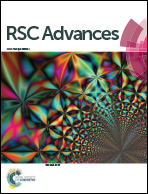An electrochemical sensing strategy for the detection of the hepatitis B virus sequence with homogenous hybridization based on host–guest recognition†
Abstract
Rapid, sensitive, and accurate DNA detection is of great significance to meet the growing demand of disease diagnostics. Herein, an ultrasensitive and highly specific electrochemical sensing strategy for detection of hepatitis B virus (HBV) DNA hybridization in homogeneous solution was presented. In this sensing protocol, magnetic nanoparticles (MNPs) were prepared and modified with β-CD. MNPs/β-CD were then used for host–guest recognition, separation and detection. In the experiment, a stem-loop structured DNA was designed as the probe to indicate the occurrence of hybridization. It was labeled with dabcyl at the 5′-end as a guest molecule and Au nanoparticles at the 3′-end as an electrochemical tag. Initially, the DNA probe retained the stem-loop configuration, which shielded dabcyl from docking with β-CD/MNP in solution due to the steric effect. While in the presence of the complementary target DNA, the stem-loop structure of the probe was dissociated and the double-stranded DNA (dsDNA) was formed as a result of the hybridization. Consequently, dsDNA was linked to β-CD/MNP owing to the host–guest recognition between β-CD and dabcyl. Thus, the hybridization events could be sensitively transduced to electrochemical signals provided by Au nanoparticles. Au nanoparticles were then captured by the electrode through an external magnetic field. The designed sensor favored discrimination between the healthy and single-nucleotide polymorphism (SNP)-containing sequences. Under the optimized detection conditions, the sensing strategy showed high sensitivity and the detection limit was down to 9.930 × 10−13 M for a complementary HBV DNA sequence.


 Please wait while we load your content...
Please wait while we load your content...